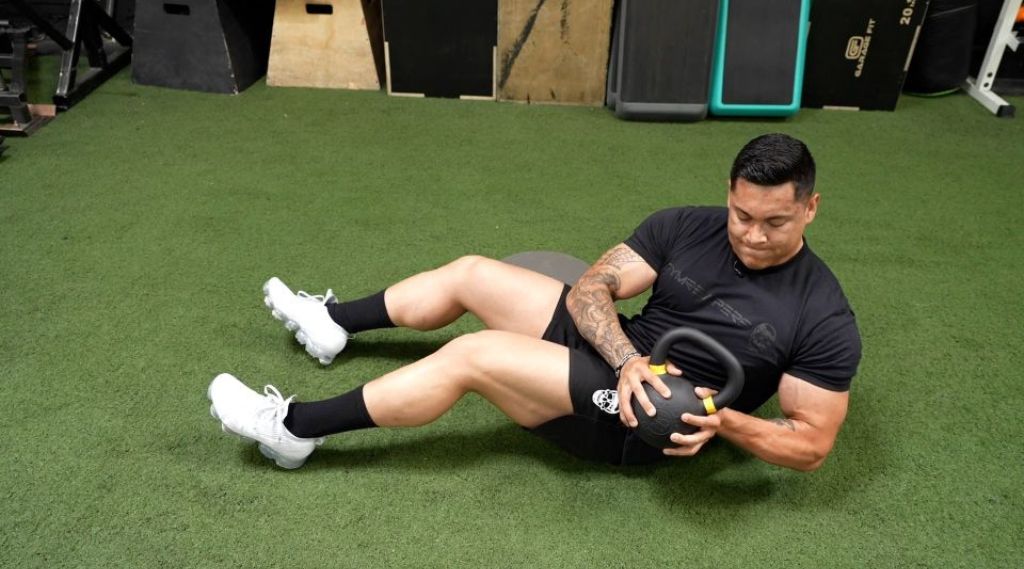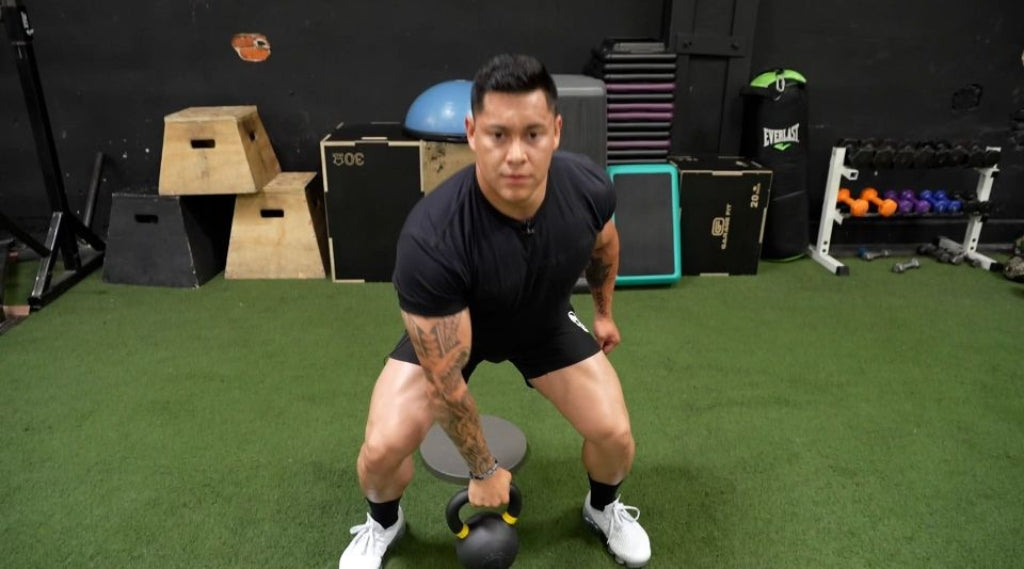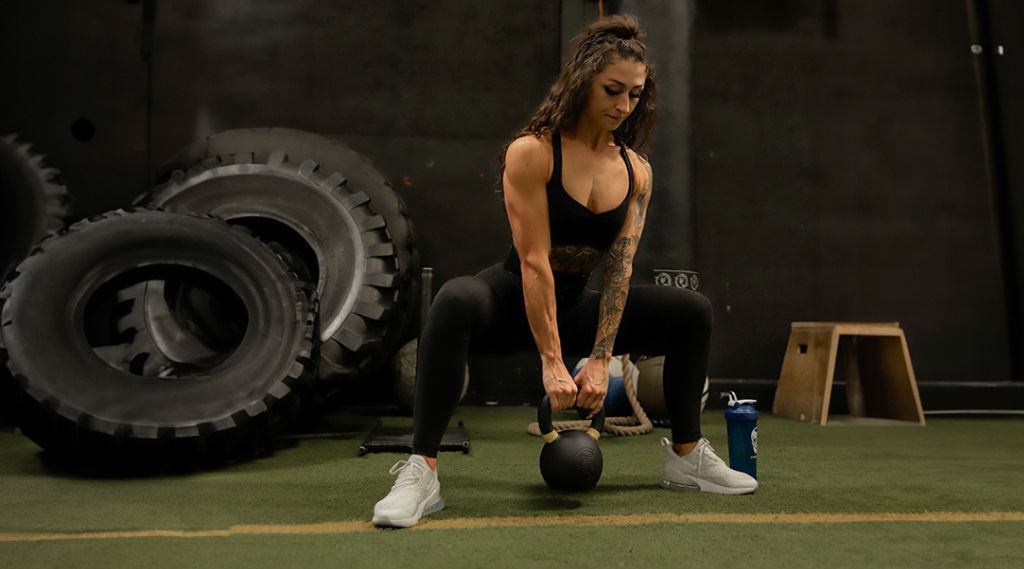Are you interested in taking your core strength to the next level? If so, the kettlebell Russian twist is one of the best exercises to include in your training routine.
The kettlebell Russian twist is a core exercise that develops the obliques through torso rotation. It also engages the rectus abdominis, transverse abdominis, and hip flexors to maintain a semi-upright torso position. Performing this movement with a kettlebell allows for continued progression over time.
To help you get the most out of the kettlebell Russian twist, I'll walk you through the proper technique, and explain which common mistakes to avoid to reduce the risk of injury.
Key Takeaways
Kettlebell Russian Twist: Anatomy Overview
The kettlebell Russian twist is an advanced core exercise that mainly works the obliques, but also recruits other muscles for positional strength and stability.
Here is a breakdown of the muscles involved:
Rectus Abdominis
The rectus abdominis, also known as the six-pack abs, promotes stability and helps maintain the semi-upright torso position. This flat, superficial muscle spans from just below the ribcage to the pelvis, bringing the two closer as it contracts.
Internal and External Obliques
The internal and external obliques flank the rectus abdominis and are responsible for twisting the upper body from side to side. They also play a role in maintaining torso stability throughout the movement.
Transverse Abdominis
The transverse abdominis is a deep core muscle that loops over the abdomen like a lifting belt, providing support alongside the obliques and abs. Its primary function is to promote stability in the hips and lower back, allowing for more controlled twisting motions.
Hip Flexors
The hip flexors and iliopsoas, specifically, are also involved in Russian twists. These muscles are responsible for hip flexion (bringing the knees closer to the chest) and assist the abdominal muscles to help you maintain the proper position.
Erector Spinae
The erector spinae is a group of muscles that run along both sides of your spine. Their primary function is to extend (straighten) the back and maintain a stable spine position.
In Russian twists, the erector spinae muscles flex isometrically (contract without changing position) to support a healthy torso position, allowing you to move from side to side with more control.
Glutes
The glutes make up the buttocks and serve numerous roles related to pelvic stability, hip extension, internal/external hip rotation, and leg abduction.
These muscles stabilize the hips during Russian twists by flexing isometrically.
Biceps/Deltoids/Pecs/Upper Back
I’m bundling these upper body muscles together because they work similarly during a kettlebell Russian twist. Specifically, these muscles flex isometrically to promote upper body stability, allowing trainees to hold onto a kettlebell while twisting from side to side.
Benefits Of Russian Twists With A Kettlebell

The benefits of Russian twists with kettlebells include:
Promotes Core Strength
The main benefit of the kettlebell Russian twist is that it develops core strength.
As discussed above, the movement targets the rectus and transversus abdominis, the obliques, erector spinae, and glutes, all of which are part of the core and play an essential role in stability and injury prevention.
Develops the Obliques
Most popular ‘core’ exercises do a poor job of training the obliques because there is little to no lateral flexion of the torso (side bending) and twisting, which is their main function.
Common movements that neglect the obliques include sit-ups and crunches, knee and leg raises, and glute bridges.
In contrast, Russian twists include a torso rotation that forces the obliques to engage and contract forcefully on each rep.
Potential For Progression
The great thing about performing Russian twists with a kettlebell is that you can continually challenge your body as you gain core strength, which will lead to better results over time.
You can start with the bodyweight version if you’re new to core training, introduce a kettlebell at some point, and gradually increase the weight you lift.
For example, the Gymreapers kettlebells range from 4 to 40 kilograms (9 to 88 lbs), giving trainees room to increase the resistance for Russian twists and other activities.
Improves Coordination
While the Russian twist is not the most complex exercise, trainees must still focus on their lower body and torso position while twisting from side to side in a controlled way. Doing so can promote kinesthetic awareness and muscle coordination.
How To Do A Kettlebell Russian Twist
Follow these steps to perform the kettlebell Russian twist properly:
-
Place an exercise mat on the floor and sit down with your knees bent, your heels on the ground, and a kettlebell at your side.
-
Grab the kettlebell with both hands and lift it to your chest.
-
Squeeze your abs, lean your torso back, and lift your heels a couple of inches off the floor, forming a wide V-shape between your thighs and upper body.
-
Take a deep breath and bring the kettlebell to the left by twisting your torso. Exhale forcefully.
-
Rotate your torso in the opposite direction as you inhale, moving the weight to your right. Squeeze your obliques momentarily and exhale before switching direction again.
- Alternate from left to right until you’re done. Keep the movements controlled, especially as you start to fatigue.
6 Common Mistakes With Kettlebell Russian Twists
To ensure you’re performing the movement correctly and reducing your risk of injury, it’s important to be aware of these common mistakes (and how to fix them).
Mistake #1: Rounding The Back Too Much
A degree of spinal flexion (rounding of the spine) is expected during Russian twists with a kettlebell. However, too much flexion can place unnecessary stress on the spine.
How To Fix
Engage your abs at the beginning of the movement to encourage a neutral spine (no arching or bending), particularly for the lower back, and aim to maintain this position as you twist.
Additionally, keep the upper back muscles engaged to keep your chest “proud” rather than allowing it to cave in as you get fatigued.
Mistake #2: Twisting Too Quickly
Doing quicker reps would allow you to get through each set faster and allow you to perform more reps before you fatigue, however, it will also reduce the effectiveness of the exercise and increase the risk of injury.
How To Fix
Maintain a consistent tempo on all reps, as during other exercises. Twist slowly to one side, pause briefly as you squeeze your obliques, and rotate in the opposite direction, breathing steadily as you do.
Ensure you’re getting a full range of motion with every twist so you’re maximizing the benefits of the exercise.
“The Russian Twist can also improve your flexibility, as long as you do it right. It’s important to do it mindfully, so you can feel the muscles being worked.”
-Julien Raby, co-owner of BoxLife and CrossFit coach
Mistake #3: Using The Arms To Move The Weight
Like many other kettlebell exercises, using the arms to move the weight means you’re missing the point. The goal is for the torso to do the work and for the arms to simply support the weight.
If your arms fatigue before your core while performing the movement, then you’re using them too much. Using the arms likely means you’re not engaging your core as well as you should be, making the exercise less effective.
How To Fix
Keep your arms fixed by gluing your elbows to your sides. The kettlebell should move from side to side only as a result of twisting your torso.
Mistake #4: Lifting Your Feet Too High
The primary objective during the activity is to twist the torso from side to side, not to raise the legs as high as possible. Lifting the feet even an inch from the floor is enough to add a layer of difficulty, making each repetition more beneficial.
That said, if elevating your legs is limiting you from performing the twisting motion, then you’re not making the most of this movement.
How To Fix
Raise your heels just an inch or two from the floor to keep your abs engaged. If that position feels too challenging, do Russian twists with your heels on the floor until you build up more core strength.
Mistake #5: Using Too Much Weight
This mistake is relatively straightforward and common, not just with Russian twists.
Using too much weight will affect movement mechanics and increase the risk of compensatory movement patterns that reduce the effectiveness of Russian twists and increase the injury risk.
How To Fix
Start with a 4-kilogram kettlebell and see how it feels. You should feel sufficiently challenged, but not to the point where you can’t smoothly twist your torso from side to side.
Mistake #6: Not Breathing Correctly
Holding your breath can cause you to fatigue more quickly and force you to stop the set before you’ve trained your core to the point where it is challenged.
How To Fix
Breathe on every repetition you do. Inhale as you initiate the twisting motion, and exhale as you complete the twist to one side and squeeze your obliques.
Best Kettlebells For Russian Twists

These kettlebells range from 4 to 40 kilograms (9 to 88 lbs), allowing beginners and advanced lifters alike to challenge themselves appropriately.
For instance, those new to Russian twists might use a 4-kilo kettlebell, whereas more advanced trainees could use a 10, 12, or even 14-kilo bell.
Another notable benefit of these kettlebells is their smooth finish, which means there is less friction that occurs between your hands and the kettlebell during exercise. As a result, calluses are less likely to occur, allowing for a more comfortable workout experience.
To top things off, you can use these kettlebells for far more than Russian twists. Whether you’re in the mood for a classic muscle-building session or a dynamic fat-burning workout, a couple of kettlebells are all you need.













Leave a comment
All comments are moderated before being published.
This site is protected by hCaptcha and the hCaptcha Privacy Policy and Terms of Service apply.